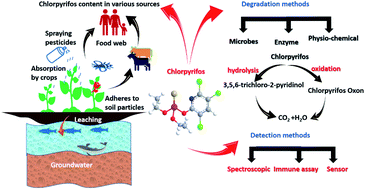Chlorpyrifos in environment and food: a critical review of detection methods and degradation pathways
Abstract
Chlorpyrifos (CP) is a class of organophosphorus (OP) pesticides, which find extensive applications as acaricide, insecticide and termiticide. The use of CP has been indicated in environmental contamination and disturbance in the biogeochemical cycles. CP has been reported to be neurotoxic and has a detrimental effect on immunological and psychological health. Therefore, it is necessary to design and develop effective degradation methods for the removal of CP from the environment. In the past few years, physicochemical (advanced oxidation process) and biological treatment approaches have been widely employed for the pesticide removal. However, the byproducts of this process are more toxic than the parent compound and along with an incomplete degradation of CP. This review focuses on the toxicity of CP, the sources of contamination, degradation pathways, physicochemical, biological, and nano-technology based methods employed for the degradation of CP. In addition, consolidated information on various detection methods and materials used for the detection have been provided in this review.

- This article is part of the themed collection: Environmental Science: Processes & Impacts: Recent Review Articles


 Please wait while we load your content...
Please wait while we load your content...